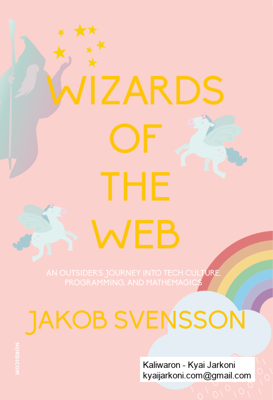by J SVENSSON — minutes after its launch, the Mariner I spacecraft veered off course and had to be blown up to prevent it from crashing in an inhabited area. The problem? A.
65 KB – 174 Pages
PAGE – 1 ============
˜˚˛˝˙ˆˇ In our connected data societies, the importance of algorithms and automated systems is obvious. They determine search engines™ rankings, what driverless cars do when a child appears on the road, and stock market changes. Today data-driven algorithms and automated systems are everywhere. While algorithms and automated systems themselves are often a topic of controversy and debate, this book is about the people behind them; it is an account of the cultures, values, and imaginations that guide programmers in their work designing and engineering software and digital technology. Technology, it is argued, is not neutral and developed free of context. And since algorithms and automated systems exercise power in connected data societies, it is pivotal to understand their creators, who could be labelled, it is argued in the book, Wizards of the Web. This book is the result of an ethnographically inspired study based on interviews with software engineers and programmers, observations made at tech head quarters and conferences in Denmark, Sweden, Brazil, Germany, India, and the US, and a case study of the introduction of algorithmic automation on the front page of a Scandinavian newspaper. The author, Jakob Svensson, is professor of Media and Communication Studies at Malmö University. The book is part of the research project Behind the Algorithm (funded by the Swedish Research Council, 2018Œ2020). ˜˚˛˝˘ Nordicom is a centre for Nordic media research at the University of Gothenburg, supported by the Nordic Council of Ministers. Nordicom, University of Gothenburg, PO Box 713, SE-405 30 Gothenburg, Sweden www.nordicom.gu.se ˘ ˆ˙˘ ˚˝˝˚ ISBN 978-91-88855-52-7 9789188855527>NORDICOM NORDICOM Nordicom is a centre for Nordic media research at the University of Gothenburg, supported by the Nordic Council of Ministers. The book has been published with support from the University of Navarra. Nordicom, University of Gothenburg, PO Box 713, SE-405 30 Gothenburg, Sweden www.nordicom.gu.se
PAGE – 5 ============
© 2021 Nordicom and the author. ˜is is an Open Access work licensed under the terms of the Creative Commons Attribution-NonCommercial-NoDerivatives 4.0 International Public licence (CC BY-NC-ND 4.0). To view a copy of the licence, visit https://creativecommons.org/licenses/by-nc-nd/4.0/ ISBN 978-91-88855-52-7 (print) ISBN 978-91-88855-53-4 (pdf)DOI: https://doi.org/10.48335/97891888555˜e publication is also available Open Access at ww w.nordicom.gu.se Published by: Nordicom University of Gothenburg Box 713 SE 405 30 GÖTEBORG SwedenCover by: Charlotta HammarWizards of the Web An Outsider™s Journey into Tech Culture, Programming, and Mathemagics Jakob Svensson
PAGE – 8 ============
fiHere™s to the crazy ones. The mis˜ts. The rebels. The troublemakers. The round pegs in the square holes. The ones who see things di˚erently. They™re not fond of rules. And they have no respect for the status quo. You can quote them, disagree with them, glorify or vilify them. About the only thing you can™t do is ignore them. Because they change things. They push the human race forward. And while some may see them as the crazy ones, we see genius. Because the people who are crazy enough to think they can change the world, are the ones who dofl. Œ from Apple™s fiThink Di˜erentfl campaign, written by creative director Rob Siltanen with Ken Segal (and a bunch of other Apple employees)
PAGE – 10 ============
9ContentsPreface 11Chapter 1. Introduction: The humans behind the screen 13Who is this book for and why should you read it? 17Outline 20Chapter 2. Situating the study 23The importance of digital technology in contemporary data societies 23Who are the programmers? 26Empirical data gathering 30Culture as an analytical tool 35Delineations, limitations, & ethics 38Chapter 3. A culture of many cultures 41Hippie culture 41Hacker culture 44Entrepreneurial & startup culture 48Middle-class, masculine, young, & suburban culture 51Chapter 4. Navigating a culture of contradictions 59Progressive hippies vs. libertarian entrepreneurs 59Pranking dudes vs. techno-missionaries 63Shy outcasts vs. attention seekers 68Self-con˚dence vs. asking for help 72Chapter 5. The geek genius among beanbags & unicorns in Lego land 77Beanbags 77Unicorns 80Prometheus 84The kings (& queen) of Geekistan 87In Lego land 91
PAGE – 11 ============
10Chapter 6. Mind-blowing ˜ow, grit, & data-driven development 95Data-driven development 96Flow 100Grit 104The mind-blowing demo 108Chapter 7. Innovative & creative solutions for a better future 113Solution creativity 113Progress, the belief in a better future 117Disruption & innovation 120In data & patterns we believe 123Chapter 8. Wizards of the web 129Among cyborg mediums, magicians, & programmer gods 129Magic through mastery of programming languages 134Wizards of the web 138From hackers to wizards 142Chapter 9. Summary & outlook 145Summary 145Mathemagics 147Bruno, making the world magic again 150Modernity & mathemagics 154The magic of dying 158The power of imagination 160References 163
65 KB – 174 Pages
